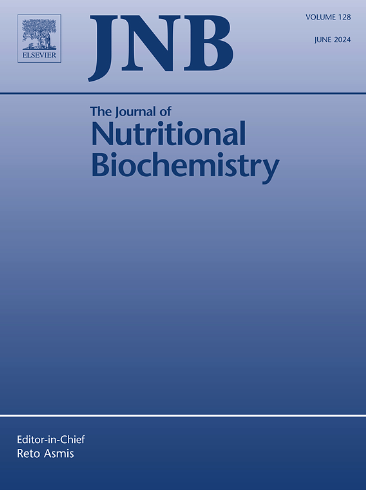Liver lipid metabolism, oxidative stress, and inflammation in glutamine-supplemented ob/ob mice
IF 4.8
2区 医学
Q1 BIOCHEMISTRY & MOLECULAR BIOLOGY
引用次数: 0
Abstract
Glutamine availability may be reduced in chronic diseases, such as type 2 diabetes mellitus (T2DM)-induced by obesity. Herein, the antioxidant, anti-inflammatory and lipid metabolism effects of chronic oral glutamine supplementation in its free and dipeptide form were assessed in ob/ob mice. Adult male C57BL/6J ob/ob mice were supplemented with L-alanyl-L-glutamine (DIP) or free L-glutamine (GLN) in the drinking water for 40 days, whilst C57BL/6J Wild-type lean (WT) and control ob/ob mice (CTRL) received fresh water only. Plasma and tissue (skeletal muscle and liver) glutamine levels, and insulin resistance parameters (e.g., GTT, ITT, insulin) were determined. Oxidative stress (e.g., GSH system, Nrf2 translocation), inflammatory (e.g., NFkB translocation, TNF-α gene expression) and lipid metabolism parameters (e.g., plasma and liver triglyceride levels, SRBP-1, FAS, ACC, and ChRBP gene expression) were also analyzed. CTRL ob/ob mice showed lower glutamine levels in plasma and tissue, as well as increased insulin resistance and fat in the liver. Conversely, chronic DIP supplementation restored glutamine levels in plasma and tissues, improved glucose homeostasis and reduced plasma and liver lipid levels. Also, Nrf2 restoration, reduced NFkB translocation, and lower TNF-α gene expression was observed in the DIP group. Interestingly, chronic free GLN only increased muscle glutamine stores but reduced overall insulin resistance, and attenuated plasma and liver lipid metabolic biomarkers. The results presented herein indicate that restoration of body glutamine levels reduces oxidative stress and inflammation in obese and T2DM ob/ob mice. This effect attenuated hepatic lipid metabolic changes observed in obesity.
补充谷氨酰胺的ob/ob小鼠肝脏脂质代谢、氧化应激和炎症。
在慢性疾病中,如肥胖引起的2型糖尿病(T2DM),谷氨酰胺可用性可能会降低。本研究在ob/ob小鼠中评估了长期口服谷氨酰胺游离和二肽形式的抗氧化、抗炎和脂质代谢作用。C57BL/6J成年雄性小鼠在饮水中添加l-丙氨酰- l-谷氨酰胺(DIP)或游离l-谷氨酰胺(GLN),连续40天,而C57BL/6J野生型瘦肉(WT)和对照小鼠(CTRL)只饮用淡水。测定血浆和组织(骨骼肌和肝脏)谷氨酰胺水平和胰岛素抵抗参数(如GTT、ITT、胰岛素)。还分析了氧化应激(如GSH系统、Nrf2易位)、炎症(如NFkB易位、TNF-α基因表达)和脂质代谢参数(如血浆和肝脏甘油三酯水平、SRBP-1、FAS、ACC和ChRBP基因表达)。CTRL /ob组小鼠血浆和组织中谷氨酰胺水平较低,同时胰岛素抵抗和肝脏脂肪增加。相反,长期补充DIP可恢复血浆和组织中的谷氨酰胺水平,改善葡萄糖稳态,降低血浆和肝脏脂质水平。此外,DIP组Nrf2恢复,NFkB易位减少,TNF-α基因表达降低。有趣的是,慢性游离GLN仅增加了肌肉谷氨酰胺储存,但降低了整体胰岛素抵抗,并减弱了血浆和肝脏脂质代谢生物标志物。本研究结果表明,恢复体内谷氨酰胺水平可降低肥胖和T2DM小鼠的氧化应激和炎症。这种作用减轻了肥胖患者肝脂质代谢的变化。
本文章由计算机程序翻译,如有差异,请以英文原文为准。
求助全文
约1分钟内获得全文
求助全文
来源期刊

Journal of Nutritional Biochemistry
医学-生化与分子生物学
CiteScore
9.50
自引率
3.60%
发文量
237
审稿时长
68 days
期刊介绍:
Devoted to advancements in nutritional sciences, The Journal of Nutritional Biochemistry presents experimental nutrition research as it relates to: biochemistry, molecular biology, toxicology, or physiology.
Rigorous reviews by an international editorial board of distinguished scientists ensure publication of the most current and key research being conducted in nutrition at the cellular, animal and human level. In addition to its monthly features of critical reviews and research articles, The Journal of Nutritional Biochemistry also periodically publishes emerging issues, experimental methods, and other types of articles.
 求助内容:
求助内容: 应助结果提醒方式:
应助结果提醒方式:


